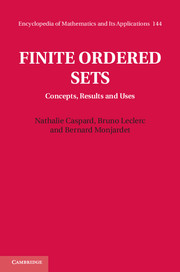Book contents
- Frontmatter
- Contents
- Preface
- 1 Concepts and examples
- 2 Particular classes of ordered sets
- 3 Morphisms of ordered sets
- 4 Chains and antichains
- 5 Ordered sets and distributive lattices
- 6 Order codings and dimensions
- 7 Some uses
- A About algorithmic complexity
- B The 58 types of connected ordered sets of size at most 5
- C The numbers of ordered sets and of types of ordered sets
- D Documentation marks
- References
- List of symbols
- Index
6 - Order codings and dimensions
Published online by Cambridge University Press: 05 February 2012
- Frontmatter
- Contents
- Preface
- 1 Concepts and examples
- 2 Particular classes of ordered sets
- 3 Morphisms of ordered sets
- 4 Chains and antichains
- 5 Ordered sets and distributive lattices
- 6 Order codings and dimensions
- 7 Some uses
- A About algorithmic complexity
- B The 58 types of connected ordered sets of size at most 5
- C The numbers of ordered sets and of types of ordered sets
- D Documentation marks
- References
- List of symbols
- Index
Summary
We have several times considered codings (Definition 3.1) from an ordered set to another one. Indeed when an ordered set has a complex structure, it is natural to try to represent it in a simpler ordinal structure. In this chapter, we choose direct products of chains as the simple ordered structures (see Section 1.5.2). A coding of the ordered set P will then be a map sending P to an ordered subset, isomorphic to P, of such a product. This notion is particularized when adding conditions on the sizes of the chains. Thus, when all chains have size k (with k a fixed integer), as always assumed in the sequel, we will speak of a k-coding. The minimum number of chains required for the existence of a k-coding of P will be called the k-dimension of P.
In the first section, we study the 2-codings of an ordered set P, and the associated 2-dimension – also called Boolean dimension. Indeed, a 2-coding of P, i.e., a coding from P to a direct product of p chains of size 2, is equivalent to a coding from P to the Boolean lattice of subsets of a set of size p (such a coding may also be called Boolean). The Boolean dimension of an ordered set P is thus the minimum size of a set a family of subsets of which, ordered by set inclusion, reproduces exactly (i.e., is isomorphic to) P.
Information
- Type
- Chapter
- Information
- Finite Ordered SetsConcepts, Results and Uses, pp. 163 - 191Publisher: Cambridge University PressPrint publication year: 2012
